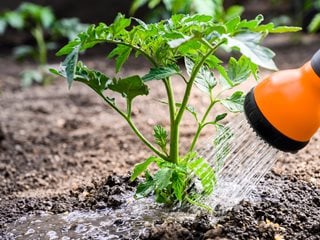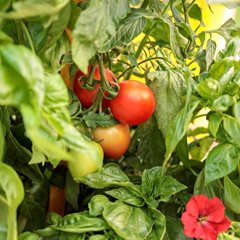Your Complete Guide to Perfectly Watering Tomato Plants
Compare methods for watering tomatoes and get tips for how to water Reviewed by Denise Kelly, Horticulturist
Photo by: Fotokostic / Shutterstock.
Tomatoes are one of the most popular additions to people's gardens. While they are a mouthwatering treat to enjoy when grown properly, getting perfectly ripe tomatoes can be a challenge. The key to growing them successfully is to avoid under or overwatering them while they develop.
METHODS FOR WATERING TOMATO PLANTS
When watering tomato plants there are a variety of different methods you can try. The most important thing is that you water them the correct amount.
Watering can:
If you opt to use a watering can, one with a rose spout will give you the best results. A spout like this disperses the water in several smaller streams rather than one large one. Something like this is preferable because too harsh of a stream can displace soil that the plant needs to continue steadily growing.
Pro tip: Watering right at the plant's roots can help keep disease and pests away compared to watering from above the plant.
Hose:
If you choose to use a hose to water your tomato plants, attach a nozzle or watering wand to help the water flow out slowly and gently for the same reasons mentioned above.
Pro tip: A soaker hose is an easy way to water all your tomatoes at once. Water seeps out of small pores along the length of the hose. Simply place the hose so it runs past the base of each plant and turn on the water!

Photo by: FotoHelin / Shutterstock.
Drip irrigation:
A drip irrigation system is one of the most effective ways to water tomato plants. For this method, water is run through small tubes placed at the base of each plant. It's effective because the water is delivered right to the roots of the plant.
Another benefit is that it makes it easy to ensure all your tomato plants receive the same amount. So a tiny adjustment can fix them all.
Pro tip: For maximum convenience, connect your drip lines to your irrigation timer. Then program them to run on certain days and times for at least a few minutes. Adjust the schedule as needed or supplement with hand watering.
Sprinkler:
A sprinkler may sound like a convenient option for watering tomato plants, but it's the least favorable option.
Sprinklers irrigate from above the plants, which gets water on the leaves. This increases the chance of diseases and pests damaging your tomatoes. Plus, the moisture evaporates quickly, leaving your plants without the water they need to thrive.
Finally, a sprinkler isn't easy to target to one particular area. So you can end up watering other plants at the same time, which might lead to weeds or overwatering other things you're trying to grow.
The bottom line:
Watering tomato plants doesn't need to be a complicated process. The most important thing is to keep the soil damp throughout the growing season and avoid the leaves whenever possible.
The best option is drip irrigation but setting this up has the highest upfront costs. Using a hose or watering can with the appropriate setup can be just as effective and less expensive.
TOMATO WATERING TIPS
Watering your tomatoes doesn’t have to be tricky. Follow these tips and you’ll be on your way to success:
- Establish deep, healthy roots by watering slowly and deeply
- Water in the morning to the keep the soil moist through the heat of the day
- Always water at the base of the plant — watering from above invites disease
- Check tomatoes growing in pots often since they dry out quickly
- Be consistent — fluctuations in water supply lead to cracking and blossom end rot
- Tomatoes need 1-2 inches of water per week, depending on the weather
- Occasionally add an organic liquid fertilizer to produce plump, juicy tomatoes
WATER NEEDS BY GROWTH STAGE
Figuring out how often to water tomatoes will vary based on their growth stage. Learning about each stage briefly will help you adjust your watering routine to fit their needs at each moment.
Seedlings:
Watering tomato plants enough when they're seedlings is vital if you want them to grow successfully past this point. Make sure the soil is damp well below the surface so that good roots can establish themselves early on.
Pro tip: Gently water your tomato seedlings with a spray bottle, usually 4-5 squirts is enough. Learn more about growing tomatoes from seed.

Photo by: Kurdyukova Olga / Shutterstock.
Young transplants:
Once you’ve transplanted your young tomatoes out into the garden, give them a good deep soak. Monitor the soil moisture and give them another soak when it is dry. Consistency is important during this time.
Mature tomatoes:
As the plants mature, mulch around the base of your plants to keep the moisture in. Keep a close eye on the weather. If it gets really hot, water them more often. If it rains, skip or reduce your watering. Place a simple rain gauge near your tomatoes to know how much water they receive.
Fruiting plants:
Keep an extra close eye on them throughout the day and continue to watch for signs of over or underwatering so you can make adjustments and ensure the tomatoes you're starting to see turn out well. Overwatering at this stage may cause fruit to crack or rot. Underwatering may result in low fruit production.
Tempting Tomatoes®
One of the easiest ways to ensure healthy plants is to grow disease-resistant varieties, such as:
WATCH FOR SIGNS OF TROUBLE
Watering tomatoes isn't an exact science. The best thing you can do is watch for signs that you're giving them too much or too little water and make adjustments as you go.
Underwatering:
Here are some signs you should keep an eye out for:
- Wilted leaves in the morning
- Tomato leaves curling
- Dry soil
- Stunted growth
If you notice these signs, try slightly increasing the amount of water you're giving them. Eventually, you'll find the sweet spot between too much water and too little water.
Overwatering:
If you’ve been watering too much you might notice these signs:
- Yellow leaves
- Dark or mushy roots
- Soggy soil
- Cracked or rotting fruit
- Showing signs of disease
If you notice these signs, pull back some on your watering. You should keep to the same schedule but give them less water each time first.
Learn more about why underwatering and overwatering may lead to yellow leaves on tomato plants.
REMEMBER: WATERING TOMATOES IS AN ART
The most important takeaway is that watering tomatoes is an art, not a science. While following general guidelines is helpful, you should keep a close eye on your plants and make adjustments based on what you see. If you keep the soil damp and avoid watering the leaves with any method you choose, you should be enjoying flavorful tomatoes in no time!
MORE ON GROWING TOMATOES:
How to Grow Tomato Plants
Staking Tomatoes: A Simple How-To Guide
RELATED:
Summer Watering Tips for Your Garden
Garden Irrigation 101

